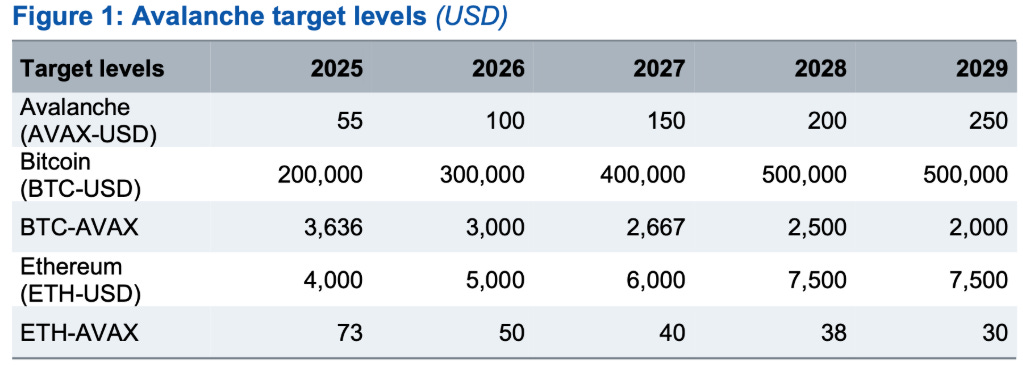Avalanche Could Surge 1,326%: Standard Chartered
The banker expects the relatively new L1 to outpace even Bitcoin’s growth trajectory in the same time.
Standard Chartered just placed a 13x bet on Layer-1 platform Avalanche.
The banking giant yesterday forecast AVAX at $250 by 2029 – up from today's $18 – as Nasdaq filed to list a Grayscale AVAX ETF, signalling a potential institutional stampede into the 15th-largest cryptocurrency.
The forecast for the blockchain's native token significantly outpaces their Bitcoin prediction of $500,000 (a 500% rise) over the same period.
How?
Its approach to scaling through Layer-1 app networks (formerly called subnets) gives it a competitive edge, Standard Chartered's analysis said.
The blockchain's Etna upgrade in December 2024 slashed L1 creation costs from $450,000 to nearly zero while improving transaction fee efficiency – a move that has already attracted 40% more developers to the ecosystem.
"At just $9 billion market capitalisation, AVAX's relatively small size amplifies the impact of incremental growth compared to giants like Bitcoin or Ethereum, the numbers paint a brutal picture of potential growth," an analyst said in the report.
Big money backs AVAX despite low prices.
BlackRock's recent $52 million deployment on Avalanche through its $1.9 billion BUIDL fund hints at growing institutional confidence in the network's potential for real-world asset tokenisation.
If approved, the Grayscale AVAX ETF would use Coinbase Custody and trade on Nasdaq, potentially mirroring the price rallies seen after Bitcoin ETF approvals.
The Avalanche Foundation isn't sitting idle. Having raised $250 million in a 2024 token sale, it now offers $55 million in developer grants through its Retro9000 and InfraBUIDL programmes – a substantial war chest for ecosystem growth.
Volatility Remains a Challenge
Despite the rosy outlook, investors should proceed with caution. AVAX's three-month volatility hovers near 100 – double that of Bitcoin – making it a significantly riskier bet.
The token has already experienced an 88% drop from its 2021 peak.
Moreover, Avalanche's subnet model, while promising, remains relatively untested compared to Ethereum's Layer-2 scaling solutions or Solana's monolithic approach.
Avalanche's potential surge could shift investment flows in the crypto market, with capital potentially moving from established giants to high-growth alternative Layer-1 blockchains.
For developers, Avalanche's reduced costs and enhanced Ethereum compatibility offer an attractive alternative to Ethereum's expensive Layer-2 networks and Solana's centralisation trade-offs.






